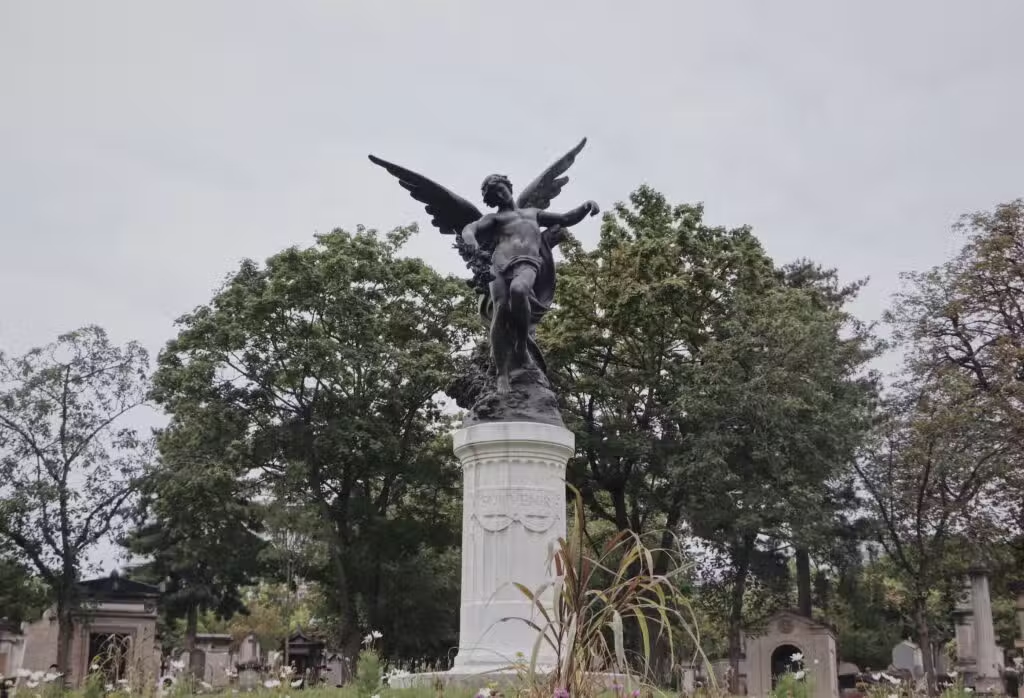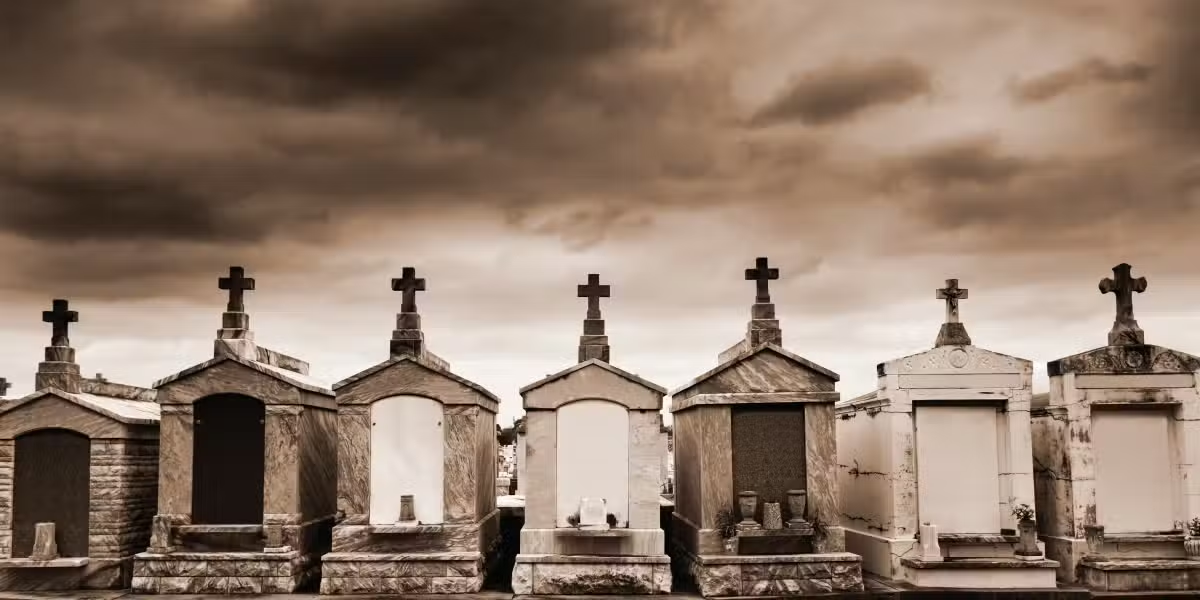On All Souls’ Day, we celebrate all those who have passed away. This author addresses questions people may have about the practicalities of a Catholic death and burial.
I recently noticed a new poster in my church that lists the corporal works of mercy. Burying the dead caught my attention and stirred up a lot of questions. I’m in my mid-60s, and thoughts of death periodically pop up as I get older. But even my young adult children wonder about the practicalities.
On Ash Wednesday, we hear the words, “Remember that you are dust, and to dust you shall return.” Because of this, many people believe it doesn’t matter what happens after we die. That isn’t true. Each person has a unique body and soul, and, although they are separated at the moment of death, they will be reunited at the end of the world. Our bodies are part of our identities as human beings, and what happens to them when we die is important.
For example, do bodies have to be buried in a coffin, or can they be left to decay in one of the increasingly prevalent “natural cemeteries,” where they gradually deteriorate to fertilize the ground? Can a body be buried in a community cemetery if it’s not specifically Catholic? Do bodies have to be buried in a cemetery at all? What about donating a body to science for research, teaching, or organ transplant? Catholics can be cremated, but then what? Can the ashes be scattered in a favorite spot or displayed on the mantel?
First, it’s important to remember that we are created in the image of God: “God created mankind in his image; in the image of God he created them” (Gen 1:27). We know our bodies are precious to God: “Do you not know that your body is a temple of the Holy Spirit within you, whom you have from God, and that you are not your own?” (1 Cor 6:19).
Because of this, our physical bodies require absolute respect, love, and dignity in both life and death. This cherished gift, this body—the only one God has given us—is unique and individual. It is not obliterated, reincarnated, or absorbed into the vast cosmos of the universe when we die. It waits for the resurrection at the end of time when soul and body will be reunited in heaven with God for eternity.
The Catholic Church teaches that the best way to honor a deceased person is through burial and interring the entire body in the ground, but cremation is also allowed. This process reduces the body to bone and ashes that are then collected into an urn. The cemetery is the traditional place for the burial of deceased remains, either in a grave or niche specifically designed for urns. The burial spot should be in or on consecrated ground and clearly marked so family, friends, and even strangers can pause in remembrance and pray for the deceased’s soul. Praying for the dead is one of the seven corporal works of mercy. The living and dead, both those in purgatory and those in heaven, are part of the communion of saints, part of the Church, and we all pray for each other.
Now, armed with our understanding of this fundamental Catholic theology, let’s look at the questions raised above.
✧ Do bodies have to be buried in a coffin, or can they be left to decay in one of the increasingly prevalent ‘natural cemeteries’? Bodily remains do not have to be embalmed and can be buried in a simple wooden coffin in a marked grave. The body and coffin will gradually decay, and the marker allows family and friends a place to pray. In this sense, a green cemetery is acceptable.
Human composting is different. In this process, the body is surrounded by plant material and microbes and placed in a container where it is treated with heat and oxygen. In about a month, the entire body—tissue and bone—is decomposed and becomes soil. There is literally nothing left of the human body, and it’s indistinguishable from the rest of the compost. This is what makes it an unacceptable alternative.
Some green cemeteries also distinguish between permanent and successive gravesites. A permanent or “perpetual” burial site will never be used for any other person or purpose. The marker will remain for visitors and future generations. A successive burial site is one that is reused after 50–60 years, when a naturally buried corpse is likely to have deteriorated. Although the cemetery keeps permanent records, there is no marker or place to visit, pray, and remember. This is not an acceptable alternative either.
✧ Can a body be buried in a community cemetery if it’s not specifically Catholic? Do bodies have to be buried in a cemetery at all? A Catholic can be buried in a non-Catholic cemetery. Part of the funeral liturgy is the “interment,” in which the ground itself is blessed and consecrated. Even a family cemetery can be consecrated in this way.
Many churches and dioceses have Catholic cemeteries, but in certain parts of the country and the world, there’s no such thing. The Code of Canon Law says that a person can be buried in the parish cemetery, if there is one, unless the family chooses otherwise. Everyone gets to decide where they want to be buried.
Cemeteries provide a connection for those who are left behind, a link between the past and future. They are places that coming generations can visit and care for. Many families regularly visit their relatives’ graves, planting flowers and brushing debris away from the stones.
November is the traditional month to remember the dead, and many cemeteries light luminaries on the graves. It’s part of our Christian responsibility to preserve the memory of the deceased and to pray for them, not only members of our immediate family but also the whole Christian community. By our prayer, we give visible witness to our Catholic faith in the Resurrection.
✧ What about donating a body to science for research, teaching, or organ transplant? In Pope John Paul II’s 1995 encyclical, Evangelium Vitae, he describes organ donation as heroism, “offering a chance of health and even of life itself to the sick who sometimes have no other hope.” Transplants are acceptable for Catholics to give and receive. Donating part of ourselves is a great act of compassion and fosters a culture of life in a world that too often prioritizes selfishness. Donating our entire bodies for research and teaching is also acceptable, as it recalls Jesus’ gift of his whole self on the cross for us.

Several requirements must be met, however. In both living and deceased organ donation, the gift must be freely given without any reward or compensation, and there can be no favoritism for the distribution of the organs. Finally, consent must also be freely given by the donor before death or by proxy after death. Nonvital organs (kidney, lung, parts of liver or pancreas) can be donated while we are alive. Single organs, or those whose absence would affect our health and life (like corneas, heart, stomach, and heart valves), can’t be donated until after death.
Organ donation after death does not change the funeral or burial; everything carries on as if the body were completely intact. Even when an entire body is given to science and is not returned to the family, a memorial Mass is celebrated. It is identical to a funeral, except that no remains are present.
✧ Catholics can be cremated, but then what? Can the ashes be scattered in a favorite spot or displayed on the mantel? Although the Church still considers the burial of the body ideal, heat cremation is allowed. In this process, high heat and flame incinerate the body’s tissues, leaving only bone fragments behind. The ashes and fragments, often called cremains, are then gathered into an urn that can be placed in an ossuary for the funeral or in the ground for burial.
Cremated remains should be treated with the same respect and dignity as a body, and nothing should be done with ashes that wouldn’t be done to an intact body. Thus, all parts should be kept together. Obviously, in cases of war or trauma, that can’t always happen, but even then, as much as possible is gathered back together. This is the rationale for the restriction against scattering ashes in a favorite location, resting them on a mantel or shelf, or dividing them into jewelry pieces.
Water cremation is a different process than heat cremation and is not in keeping with Catholic teaching. Also called alkaline hydrolysis, it uses water, potassium hydroxide or sodium hydroxide, heat, and pressure to dissolve a body within 3–16 hours. Ultimately, the body is reduced to bone fragments and about 100 gallons of fluid. Proponents say it is a gentler process, uses less energy, and is more palatable to family members who might find flame cremation difficult to accept.
The difference between heat and water cremation is what happens at the end. In heat cremation, the bone fragments and ashes are gathered together into an urn. In water cremation, the bone fragments can be retrieved, but the 100 pounds of fluid is poured down the drain as wastewater. The process is legal in 21 states, though not all have functioning facilities available.
And so . . .
The world will continue to find new ways to deal with death. Even now, the technology to turn human remains into manufactured diamonds is available. Just because something is available, though, doesn’t make it right. The best way to consider future options is to remember the basic tenets of our Catholic teaching.
Body parts should be kept together and treated with love and respect, whether buried or cremated. Human remains cannot be turned into something else, and the burial site needs to be clearly marked. For Catholics, the practical details of dealing with death speak loudly to our faith and our certainty that we will be with God, body and soul, for eternity.
We know our bodies are precious to God: “Do you not know that your body is a temple of the Holy Spxirit within you, whom you have from God, and that you are not your own?” (1 Cor 6:19).



1 thought on “A Practical Guide to Death for Catholics ”
Thank you for this deeply compassionate and clarifying article. As someone who has often wondered about the Catholic teachings surrounding death—especially the practical “what, where, how” questions—this guide eased many of my uncertainties. I especially appreciated how you balanced theological truth with practical care: affirming that our bodies are sacred, that burial or cremation are allowed (with respect), and that our choices—even in death—reflect our faith.